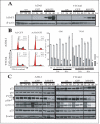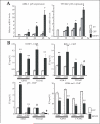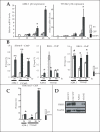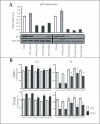Reexpression of hSNF5 in malignant rhabdoid tumor cell lines causes cell cycle arrest through a p21(CIP1/WAF1)-dependent mechanism
- PMID: 20179200
- PMCID: PMC2831128
- DOI: 10.1158/0008-5472.CAN-09-1922
Reexpression of hSNF5 in malignant rhabdoid tumor cell lines causes cell cycle arrest through a p21(CIP1/WAF1)-dependent mechanism
Abstract
Loss of hSNF5 function is usually observed in malignant rhabdoid tumor (MRT), a highly aggressive pediatric neoplasm. Previous studies have shown that reexpression of hSNF5 in MRT cell lines causes G1 cell cycle arrest with p16(INK4A), p21(CIP1/WAF1), and cyclin D1 playing key roles in MRT cell growth control. However, we have shown that reexpression of hSNF5 induced cell cycle arrest in the absence of p16(INK4A) expression. These results indicate that the mechanism of hSNF5-induced cell cycle arrest is context dependent. Here, we investigated the relationship between p21(CIP1/WAF1) and hSNF5 in the regulation of growth using several MRT cell lines. We found that G1 cell cycle arrest occurred concomitant with an increase in p21(CIP1/WAF1) mRNA and protein levels and preceded p16(INK4A) mRNA and protein upregulation. Chromatin immunoprecipitation data confirmed that hSNF5 appeared at both p21(CIP1/WAF1) and p16(INK4A) promoters after reexpression. We further showed that p21(CIP1/WAF1) induction showed both p53-dependent and p53-independent mechanisms. We also showed that reduction of p21(CIP1/WAF1) expression by RNAi significantly inhibited hSNF5-induced G(1) arrest. Our results show that both p21(CIP1/WAF1) and p16(INK4A) are targets for hSNF5 and that p21(CIP1/WAF1) upregulation during hSNF5-induced G(1) arrest precedes p16(INK4A) upregulation. These findings indicate that SNF5 mediates a temporally controlled program of cyclin-dependent kinase inhibition to restrict aberrant proliferation in MRT cells.
Figures






Similar articles
-
SNF5 reexpression in malignant rhabdoid tumors regulates transcription of target genes by recruitment of SWI/SNF complexes and RNAPII to the transcription start site of their promoters.Mol Cancer Res. 2013 Mar;11(3):251-60. doi: 10.1158/1541-7786.MCR-12-0390. Epub 2013 Jan 30. Mol Cancer Res. 2013. PMID: 23364536 Free PMC article.
-
Loss of the hSNF5 gene concomitantly inactivates p21CIP/WAF1 and p16INK4a activity associated with replicative senescence in A204 rhabdoid tumor cells.Cancer Res. 2005 Nov 15;65(22):10192-8. doi: 10.1158/0008-5472.CAN-05-1896. Cancer Res. 2005. PMID: 16288006
-
P16INK4a is required for hSNF5 chromatin remodeler-induced cellular senescence in malignant rhabdoid tumor cells.J Biol Chem. 2004 Jan 30;279(5):3807-16. doi: 10.1074/jbc.M309333200. Epub 2003 Nov 6. J Biol Chem. 2004. PMID: 14604992
-
Examination of the expanding pathways for the regulation of p21 expression and activity.Cell Signal. 2010 Jul;22(7):1003-12. doi: 10.1016/j.cellsig.2010.01.013. Epub 2010 Jan 25. Cell Signal. 2010. PMID: 20100570 Free PMC article. Review.
-
p21 in cancer: intricate networks and multiple activities.Nat Rev Cancer. 2009 Jun;9(6):400-14. doi: 10.1038/nrc2657. Nat Rev Cancer. 2009. PMID: 19440234 Free PMC article. Review.
Cited by
-
Evaluation of the role of downregulation of SNF5/INI1 core subunit of SWI/SNF complex in clear cell renal cell carcinoma development.Am J Cancer Res. 2017 Nov 1;7(11):2275-2289. eCollection 2017. Am J Cancer Res. 2017. PMID: 29218250 Free PMC article.
-
Chromatin remodeling and cancer: the critical influence of the SWI/SNF complex.Epigenetics Chromatin. 2025 Apr 23;18(1):22. doi: 10.1186/s13072-025-00590-w. Epigenetics Chromatin. 2025. PMID: 40269969 Free PMC article. Review.
-
Coordinating cell proliferation and differentiation: Antagonism between cell cycle regulators and cell type-specific gene expression.Cell Cycle. 2016;15(2):196-212. doi: 10.1080/15384101.2015.1120925. Cell Cycle. 2016. PMID: 26825227 Free PMC article. Review.
-
Fibroblast growth factor receptors as novel therapeutic targets in SNF5-deleted malignant rhabdoid tumors.PLoS One. 2013 Oct 30;8(10):e77652. doi: 10.1371/journal.pone.0077652. eCollection 2013. PLoS One. 2013. PMID: 24204904 Free PMC article.
-
SNF5 reexpression in malignant rhabdoid tumors regulates transcription of target genes by recruitment of SWI/SNF complexes and RNAPII to the transcription start site of their promoters.Mol Cancer Res. 2013 Mar;11(3):251-60. doi: 10.1158/1541-7786.MCR-12-0390. Epub 2013 Jan 30. Mol Cancer Res. 2013. PMID: 23364536 Free PMC article.
References
-
- Beckwith JB, Palmer NF. Histopathology and prognosis of Wilms tumors: results from the First National Wilms’ Tumor Study. Cancer. 1978;41:1937–48. - PubMed
-
- Hoot AC, Russo P, Judkins AR, Perlman EJ, Biegel JA. Immunohistochemical analysis of hSNF5/INI1 distinguishes renal and extra-renal malignant rhabdoid tumors from other pediatric soft tissue tumors. Am J Surg Pathol. 2004;28:1485–91. - PubMed
-
- Biegel JA, Tan L, Zhang F, Wainwright L, Russo P, Rorke LB. Alterations of the hSNF5/INI1 gene in central nervous system atypical teratoid/rhabdoid tumors and renal and extrarenal rhabdoid tumors. Clin Cancer Res. 2002;8:3461–7. - PubMed
-
- Tomlinson GE, Breslow NE, Dome J, et al. Rhabdoid tumor of the kidney in the National Wilms’ Tumor Study: age at diagnosis as a prognostic factor. J Clin Oncol. 2005;23:7641–5. - PubMed
-
- Versteege I, Sevenet N, Lange J, et al. Truncating mutations of hSNF5/INI1 in aggressive paediatric cancer. Nature. 1998;394:203–6. - PubMed
Publication types
MeSH terms
Substances
Grants and funding
LinkOut - more resources
Full Text Sources
Other Literature Sources
Research Materials
Miscellaneous

